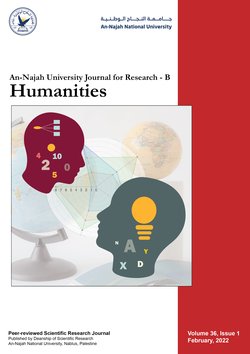The Canaanites: Their spatial origin, geographical borders, and sociopolitical landscape during the bronze ages (3600-1200 B.C.E)
Authors:
Article info
2021-03-28
2021-07-28
577 - 598
Keywords
- Land of Canaan
- Bronze Ages
- Southern Levant
- Canaanites
Abstract
This present study focuses on the inhabitants of the southern Levant (Canaan) during the Bronze Ages, based on a variety of physical archaeological evidence that has been uncovered both in the Levant itself and in neighboring lands. The aims of this study are fourfold: (1) to present the names of this region known to us from surviving written sources dated to the second and first millennia BCE, and to identify the spatial and ethnic origins of the Canaanites; (2) to identify the geographic borders which the neighboring peoples observed in relation to Canaan; (3) to present the Canaanites' social landscape and its manifestations in the emergence and ultimate prevalence of the city-state system throughout the region; and finally, (4) to demonstrate the political complexities that prevailed in the southern Levant during the Bronze Ages. This study pointed the author to two main conclusions: (a) that the Canaanites were native to the southern Levant and can be seen as a natural extension of the population that had inhabited the region during the Neolithic period, and (b) that the functional geographic borders of Canaan changed repeated over time, witnessing several expansions and contractions. The methodology implemented in this study consists of a review and analysis of the existing scholarly literature related to this subject; biblical texts, by their very nature, were not included in the study.
Al-Houdalieh, S. (2023). The Canaanites: Their spatial origin, geographical borders, and sociopolitical landscape during the bronze ages (3600-1200 B.C.E). An-Najah University Journal for Research - B (Humanities), 37(4), 577–598. https://doi.org/10.35552/0247-037-004-001
[1]S. Al-Houdalieh, “The Canaanites: Their spatial origin, geographical borders, and sociopolitical landscape during the bronze ages (3600-1200 B.C.E),” An-Najah University Journal for Research - B (Humanities), vol. 37, no. 4, pp. 577–598, Apr. 2023, doi: 10.35552/0247-037-004-001.
Al-Houdalieh, Salah. “The Canaanites: Their Spatial Origin, Geographical Borders, and Sociopolitical Landscape during the Bronze Ages (3600-1200 B.C.E).” An-Najah University Journal for Research - B (Humanities), vol. 37, no. 4, Apr. 2023, pp. 577–98. Crossref, https://doi.org/10.35552/0247-037-004-001.
1.Al-Houdalieh S. The Canaanites: Their spatial origin, geographical borders, and sociopolitical landscape during the bronze ages (3600-1200 B.C.E). An-Najah University Journal for Research - B (Humanities) [Internet]. 2023 Apr;37(4):577–98. Available from: http://dx.doi.org/10.35552/0247-037-004-001
Al-Houdalieh, Salah. “The Canaanites: Their Spatial Origin, Geographical Borders, and Sociopolitical Landscape during the Bronze Ages (3600-1200 B.C.E).” An-Najah University Journal for Research - B (Humanities) 37, no. 4 (April 2023): 577–98. https://doi.org/10.35552/0247-037-004-001.
الكنعانيون: أصولهم المكانية، وحدودهم الجغرافية، ومشهدهم الاجتماعي-السياسي خلال العصور البرونزية (3600-1200 ق.م)
المؤلفون:
معلومات المقال
2021-03-28
2021-07-28
577 - 598
الكلمات الإفتتاحية
- Land of Canaan
- Bronze Ages
- Southern Levant
- Canaanites
الملخص
تتناول هذه الدراسة سكان منطقة جنوبي بلاد الشام (بلاد كنعان) خلال العصور البرونزية بالبحث والتحليل، وذلك بالاعتماد على الشواهد الأثرية المادية المختلفة التي تم الكشف عنها في بلاد الشام نفسها وفي دول الجوار على حد سواء. وتهدف هذه الدراسة إلى تسليط الضوء على أربعة مواضيع رئيسة، هي: (1) تسميات هذه المنطقة، والأصول المكانية والعرقية لسكانها. (2) الرقعة الجغرافية التي ساد فيها الكنعانيون، وحدودهم الجغرافيّة مع دول الجوار. (3) طبيعة المشهد الاجتماعي الذي ساد في هذه المنطقة وما ترافق معه من الانتقال من نظام القبيلة البسيط إلى النظام المدني المعقد الذي أفرز نشوء الدويلة-المدينة. (4) تعقيدات المشهد السياسي الذي امتازت به بلاد كنعان بسبب غياب التوحيد السياسي، بالإضافة إلى أطماع دول الجوار، وخصوصاً الدولة المصريّة الحديثة. وقد توصلت هذه الدراسة إلى أن بلاد كنعان كانت ذات حدود جغرافيّة تتمدد تارة وتتقلص طوراً آخر، وأن الكنعانيين أصيلين في بلاد الشام ويشكلون امتداداً طبيعياً لسكان نفس المنطقة من العصر الحجري الحديث. وقد تم الاعتماد في كتابة هذا البحث على مراجعة الأدبيات ذات العلاقة، ولكن تم استثناء النصوص التوراتية منها
Al-Houdalieh, S. (2023). The Canaanites: Their spatial origin, geographical borders, and sociopolitical landscape during the bronze ages (3600-1200 B.C.E). An-Najah University Journal for Research - B (Humanities), 37(4), 577–598. https://doi.org/10.35552/0247-037-004-001
[1]S. Al-Houdalieh, “The Canaanites: Their spatial origin, geographical borders, and sociopolitical landscape during the bronze ages (3600-1200 B.C.E),” An-Najah University Journal for Research - B (Humanities), vol. 37, no. 4, pp. 577–598, Apr. 2023, doi: 10.35552/0247-037-004-001.
Al-Houdalieh, Salah. “The Canaanites: Their Spatial Origin, Geographical Borders, and Sociopolitical Landscape during the Bronze Ages (3600-1200 B.C.E).” An-Najah University Journal for Research - B (Humanities), vol. 37, no. 4, Apr. 2023, pp. 577–98. Crossref, https://doi.org/10.35552/0247-037-004-001.
1.Al-Houdalieh S. The Canaanites: Their spatial origin, geographical borders, and sociopolitical landscape during the bronze ages (3600-1200 B.C.E). An-Najah University Journal for Research - B (Humanities) [Internet]. 2023 Apr;37(4):577–98. Available from: http://dx.doi.org/10.35552/0247-037-004-001
Al-Houdalieh, Salah. “The Canaanites: Their Spatial Origin, Geographical Borders, and Sociopolitical Landscape during the Bronze Ages (3600-1200 B.C.E).” An-Najah University Journal for Research - B (Humanities) 37, no. 4 (April 2023): 577–98. https://doi.org/10.35552/0247-037-004-001.

Since 2019
Cite Score (Scopus): 0.5
Time to First Decision: 7 Days
Submission to Acceptance: 60 Days
Acceptance to Publication: 10 Days
Acceptance Rate: 20%
Call for Papers:
Special Issue on
Innovative Assessment in the Age of AI: Strategies for Quality
Why should you
Publish With Us?
An-Najah National University
Nablus, Palestine
Nablus, Palestine
- P.O. Box
- 7, 707
- Fax
- (970)(9)2345982
- Tel.
- (970)(9)2345560
- (970)(9)2345113/5/6/7-Ext. 2628
- [email protected]
- EIC
- Prof. Waleed Sweileh
An-Najah University Journal for Research - B (Humanities) © 1986 by An-Najah University, Nablus, Palestine is licensed under CC BY-NC 4.0
